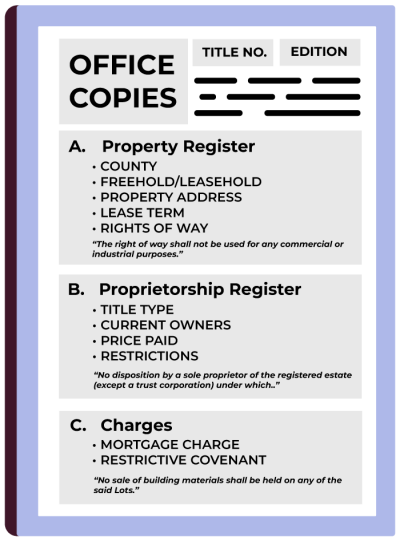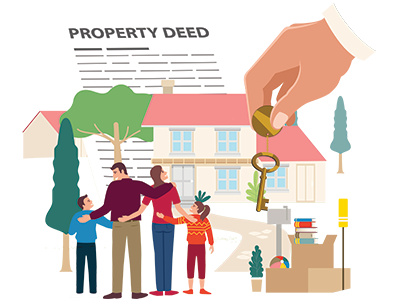Office Copy Entries Explained for 2024
- An Office Copy Entry is a snapshot of the title held at the Land Registry.
- It may not include all of the covenants from the original conveyancing deeds.
- In most cases, the information is provided instantly.
- The information is out of date the moment it is obtained.
- You need the Title Information for a remortgage, sale, or purchase.
- It costs £3 to order. However, some companies charge an admin fee to obtain it.
Office copy entries are certified copies of the land or charge certificate obtained from the Land Registry, confirming ownership of a property.
An office copy entry is officially known as an Official Copy of Register of Title – and also a title register – and, in effect, is the certified, modern equivalent of the old Title Deeds, physical documents which were used in previous times to prove property ownership and show the ownership chain. In effect, it is a snapshot of the details pertinent to the most recent title deeds relating to a particular property, which a vendor's solicitor normally orders to pass onto the buyer's solicitor for perusal. It is normally always accompanied by the Land Registry Title Plan which shows the general position of the property.
Nowadays, the only time the Land Registry has physical original Title Deeds in its possession is when a property is being registered for the first time, in which case a solicitor registering the property must send them in to be scanned, after which they are returned to the solicitor.
Why would you get an office copy entry?
You obtain an office copy entry as an owner of a property to prove that ownership if you intend to sell it. If the property is registered anyone can buy an office copy entry. The buyer can ascertain who owns the property (freeholder), whether they have leased it out to one or more leaseholders and whether there are any charges on the property, such as a mortgage from a lender that hasn’t yet been redeemed.
There may, for example, be restrictions which might affect registering a new mortgage. There may also be covenants. You can also learn about the history of ownership of the property and other important matters, such as any changes to its legal boundary.
How much does an office copy entry cost?
You can buy an office copy entry from the Land Registry for £3.
What do office copy entries show?
An office copy entry must have 'Official Copy of the Register of Entries' at the head of the first page. If it is not or is headed 'Register View', then it is not an official copy and is not admissible as evidence of the contents of the register.
There are 4 sections:

The Header
The header of the office copy includes:
- The title number. The Land Registry gives a unique title number for every title in England and Wales.
- Edition Date. This date indicates when the title was last updated. This may have been, for example, when the property was last sold, when a mortgage was registered or when a restriction or notice was added. Any change causes a new edition to be created.
- Date and time of official copy. This is when the official copy was produced, and the Land Registry guarantees that the copy’s contents accurately reflect the information held at that date and time. The office copy is technically out of date as soon as it is produced.
- Land Registry office that deals with the title. This sets down the details of which office at the Land Registry is responsible for registration applications for this property.
Section A - Property Register
This describes the land in the title and any rights which benefit it.
- County : District. You can find out the county the property is in and which local authority it comes under.
- Property Description. This tells you whether the property is freehold or leasehold, details its address, and shows that the land’s boundaries are edged on the title plan. The date at the start of the entry is the date of first registration with the Land Registry.
- Lease terms. (if leasehold) The original lease term is stated.
- Rights. Rights of way, easements, light, and utilities will be listed here.
Section B - Proprietorship Register
This part tells you the class of title and who the current owner is and provides information about anything that affects the right of disposal.
- Title Class. This can be one of the following four: Absolute, Possessory, Qualified, or Good.
- Proprietor names. Entry 1 is the name/s and address/es of the legal owners the Land Registry holds for contact purposes. The date in brackets is the date when these owners were registered as such.
- Price Paid. Entry 2 is the price paid when the current legal owners bought/transferred the property and the date it was bought. If the property has not been sold since April 2000, there will be no entry here because the Land Registry’s information only extends this far.
- Personal Covenants. This section lists any personal covenants given by the former owner to the current owner; this might be an indemnity covenant.
- Restrictions. Entries here prevent dispositions from being registered without an additional action being performed, which is normally obtaining a certificate or deed of consent from a third party. Commonly, restrictions are instituted by mortgage lenders; they might, for example, require a lender’s consent before any new mortgage is permitted on the property or before the property can change hands.
Section C - Charges Register
This section sets down any existing mortgages, other financial charges, notices and, restrictive covenants (including, for example, easement rights) which affect the property. They appear in the order they were originally registered, and earlier entries have priority over later entries.
Why can’t I get an office copy entry?
If your property isn’t on the register, you must apply for first registration and send in the original title deeds. You should ask the solicitor who acted for you when you bought the property or the relevant mortgage company if you bought using a mortgage.
If you cannot get hold of your Title Deeds, you must supply a statutory declaration or statement of truth and prove your ID. In the worst-case scenario, you may only be able to obtain a possessory title, although you can apply to convert a possessory title to an absolute title after 15 years.
For official Government guidance about finding out information about properties, click on Get Information About Properties
When do I need a copy of the title?
A solicitor must obtain an up-to-date copy of your title for any transaction that changes the title, including:
- Remortgage
- Transfer of equity
- Sale
Andrew started his career in 2000 working within conveyancing solicitor firms and grew hands-on knowledge of a wide variety of conveyancing challenges and solutions. After helping in excess of 50,000 clients in his career, he uses all this experience within his article writing for SAM, mainstream media and his self published book How to Buy a House Without Killing Anyone.
Caragh is an excellent writer and copy editor of books, news articles and editorials. She has written extensively for SAM for a variety of conveyancing, survey, property law and mortgage-related articles.









